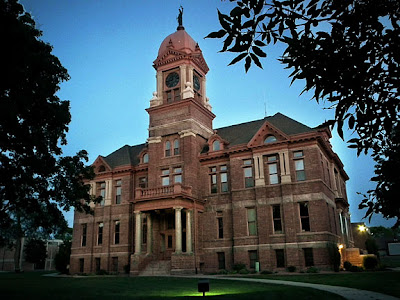 |
| Pipestone County Courthouse made of local stone in the Beaux Arts style. |
 |
| Centre: First National Bank with arch |
 |
| Wind turbine sighted above trees. |
 |
| The original Richardsonian arch is gone. |
But Pipestone still has heritage Pipestone — the cluster of century-plus buildings in its downtown core. And Pipestone still has pipestone — the special stone that gave the town its name. Only native Americans now quarry the unique, local stone used for making ceremonial pipes.
My wife and I stayed at the historic Calumet Inn. It wasn't expensive and it shouldn't be. The inn is one of those places that is trying hard but you get the feeling that cash flow is a problem. The little inn didn't even have a proper hotel parking lot. This was no surprise as century hotels were built before the advent of the car. At that time, guests simply walked from the train station to the hotel. We parked the Morgan on the street. The downtown's quiet and parking was not a problem.
 |
| Our room in the Calumet Inn. |
Click the link and check out the inn and the various packages offered. The little inn wants, no needs, your business.
Pipestone National Monument
Outside of town, the Pipestone National Monument was established in 1937, restoring quarrying rights to the Native Americans. During the summer, natives conduct cultural demonstrations such as traditional pipe making. Craftsmen, many third or fourth generation pipe makers, carve ceremonial pipes using the unique stone from the Pipestone Quarry located within the park.
Visitors are encouraged to take a three-quarter mile (1.2 km) self-guided walk to view the pipestone quarries and a waterfall. A trail guide is available at the visitor center.
About 260 acres of the area has been restored to native tallgrass prairie. A larger area of restored tallgrass prairie and a small Bison herd are maintained by the Minnesota DNR at Blue Mounds State Park, 20 miles (32 km) to the south.
 |
| Pipestone Quarry: George Catlin Smithsonian Museum/Renwick Gallery The town's Carnegie Library is just a short walk from the Calumet Inn. |


